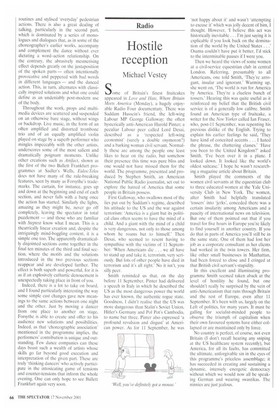Dance
Eidos:Telos (Ballett Frankfurt, Sadler's Wells)
Thinking dancers
Giannandrea Poesio
Immediacy might not be the first word that springs to mind when you think or talk about Eidos:Telos, a 1995 three-part piece created by William Forsythe in choreographic association with the ensemble', as the programme reports. Because the work is so complex and thought-provoking, it needs to be thoroughly assimilated before judgments can be made. In an ideal world, therefore, one should see it more than once to discover and appreciate its intensely multi-layered structure and varied content. The need to let it sink in, however, does not prevent both experienced dancegoers and laypeople from reacting instantly to its many captivating dramatic choreographic and visual stimuli. Both on the opening night and on the second night, each of the three sections of Eidos:Telos was greeted with an interesting mixture of enthusiastic applause and perplexity.
The work has the recognisable signature of Forsythe's style and genre. In line with the rest of his ceuvre, classical ballet is pushed beyond the boundaries of its rules and coupled with other forms of movement; these encompass basic contemporary techniques as well as a thousand other genres, including quotations from music-hall
routines and stylised 'everyday' pedestrian actions. There is also a great dealing of talking, particularly in the second part, which is dominated by a series of monologues and dialogues that, as in some of the choreographer's earlier works, accompany and complement the dance without ever dictating a word–action relationship. On the contrary, the abrasively mesmerising effect depends greatly on the juxtaposition of the spoken parts — often intentionally provocative and peppered with had words in different languages — and the danced action. This, in turn, alternates with classically inspired solutions and what one could define as an undeniably post-modern use of the body.
Throughout the work, props and multimedia devices are scattered and suspended on an otherwise bare stage, without wings or backdrop. Live music, in the form of an often amplified and distorted trombone trio and of an equally amplified violin played on stage by a superb performer who mingles impeccably with the other artists, underscores some of the most salient and dramatically poignant moments. Unlike other creations such as Artifact, shown as the first of the two Ballett Frankfurt programmes at Sadler's Wells, Eidos:Telos does not have many of the rule-breaking features, seen by many as Forsythe's trademarks. The curtain, for instance, goes up and down at the beginning and end of each section, and never falls with a bang once the action has started. Similarly the lights, amazing as they might be, never go off completely, leaving the spectator in total puzzlement — and those who are familiar with Steptevt know what I mean. This is a theatrically linear creation and, despite the intriguingly mind-boggling content, it is a simple one too. The apparently dramatically disjointed sections come together in the final ten minutes of the third and final section, where the motifs and the solutions introduced in the two previous sections reappear and are developed further. The effect is both superb and powerful, for it is as if an explosively cathartic denouement is unexpectedly taking place in front of you.
Indeed, there is a lot to take on board. and I found particularly interesting the way some simple cast changes gave new meanings to the same actions between one night and the other. Just by moving a dancer from one place to another on stage, Forsythe is able to create and offer to his audience new solutions and possibilities. Indeed, as that 'choreographic association' mentioned in the programme implies, the performers' contribution is unique and outstanding. Few dance companies can these days boast such a wealth of artists whose skills go far beyond good execution and interpretation of the given part. These are truly 'thinking dancers' who actively participate in the intoxicating game of tensions and counter-tensions that inform the whole evening. One can only hope to see Ballett Frankfurt again very soon.























































































 Previous page
Previous page